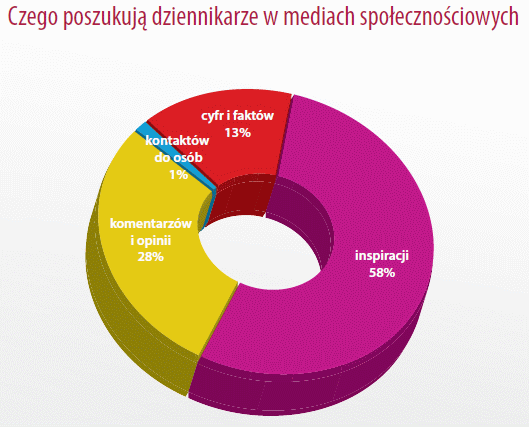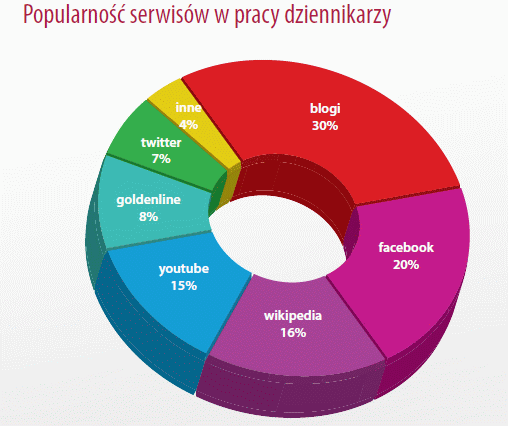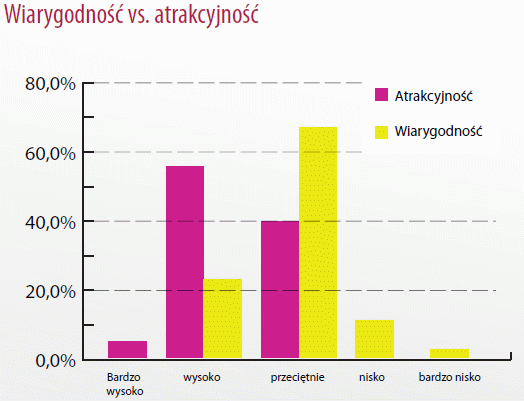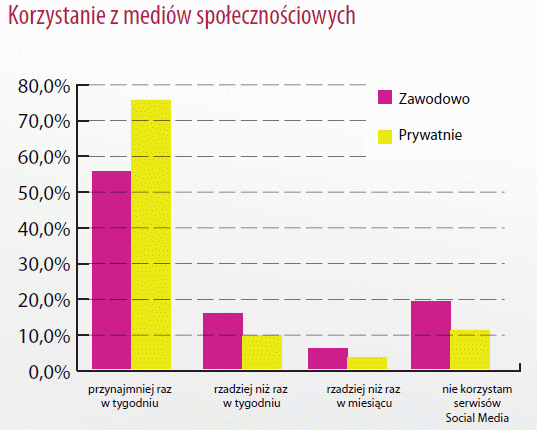 Multi Communications, Journalists and Social Media 2011
Multi Communications, Journalists and Social Media 2011Journalists most often visit blogs, which are also considered the most reliable sources of knowledge and information among all social media platforms. Facebook ranks second in both popularity and credibility, with Wikipedia following in third place. This pattern shows that the ranking for credibility aligns with the popularity ranking.
 Multi Communications, Journalists and Social Media 2011
Multi Communications, Journalists and Social Media 2011The Multi Communications study reveals that information found by journalists on social media is considered more attractive than credible. A quarter of respondents rated the credibility of such information as high, but none rated it very high. On the other hand, no one rated the attractiveness of social media content as low or very low. Around 60% of respondents rated the credibility of these sources as high or very high.
 Multi Communications, Journalists and Social Media 2011
Multi Communications, Journalists and Social Media 2011Polish journalists admit to frequently using social media platforms. Nearly two-thirds use them regularly for work, while even more use them for personal purposes, with about three-quarters of media workers indicating personal use.
 Multi Communications, Journalists and Social Media 2011
Multi Communications, Journalists and Social Media 2011The survey was conducted independently by Multi Communications in November 2011. Over 110 journalists from various media types (e.g., press, internet, TV) and covering different topics (business, new technologies, lifestyle) participated in the study.
COMMERCIAL BREAK
New articles in section Media industry
Advertising market 2025. Poland, Europe and the World
Marcin Grządka
The global advertising market is growing by 8.8% in 2025 and will reach a value of 1.14 trillion dollars. The industry result in Europe records slightly lower dynamics, at the level of 5.8%. In this comparison, Poland performs clearly above the average. We will record an increase of 8.9% this year and a value of 18.56 billion PLN - estimates WPP Media in the annual report "This Year Next Year".
The print media market 2025. Three global trends
Krzysztof Fiedorek
The market value is 359.53 billion dollars, yet the erosion is visible to the naked eye. The decline for newspapers will amount to -2.3 percent. Despite this, print retains strength: it generates 76 percent of subscription revenues and enjoys 82 percent consumer trust. The future of the industry is defined by hybrid strategies and niche specialization.
Journalism in the age of AI. Why people prefer humans over machines
Krzysztof Fiedorek
Only 12% of people accept news created solely by AI, while 62% prefer those written by humans. At the same time, only 19% notice labels indicating the use of artificial intelligence, while younger audiences ask AI to explain the content to them. These are the findings of the Reuters Institute report on artificial intelligence in media.
See articles on a similar topic:
Women in media 2025. Editorial power knows no equality
KFi
Only 27% of editors-in-chief in the media are women, even though they make up 40% of journalists. In 9 out of 12 countries studied by the Reuters Institute, women in media are less likely to get promoted. It seems that equality in newsrooms is lagging behind broader society. And the gaps go much further.
Automation of Disinformation. Global Risks Report 2025 and Media
Krzysztof Fiedorek
Disinformation and information manipulation have ranked first among global threats in both the two-year and ten-year perspectives. A particularly concerning factor is that social media algorithms often favor controversial or shocking content, further fueling disinformation.
Energy under attack. Disinformation threatens Poland’s power transition
KFi
One in five online messages about energy may be fake. Between 2022 and 2025 nearly 70,000 publications warning and condemning disinformation in this strategic sector were recorded in Polish media. They generated a reach of 1.19 billion impressions.
Artificial Intelligence in the Media. Reuters Digital News Report 2024
Krzysztof Fiedorek
AI has gained prominence in recent years, and its application in producing, distributing, and presenting news content continues to grow. However, this development is met with mixed feelings by audiences, which has significant consequences for media trust and its future.





























